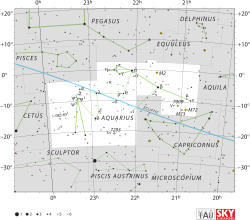66 Aquarii

| |
| Observation data Epoch J2000 Equinox J2000 | |
|---|---|
| Constellation | Aquarius |
| Right ascension | 22h 43m 35.23307s[1] |
| Declination | –18° 49′ 49.3557″[1] |
| Apparent magnitude (V) | 4.673[2] |
| Characteristics | |
| Spectral type | K3 III[3] |
| U−B color index | +1.549[2] |
| B−V color index | +1.376[2] |
| Variable type | suspected[4] |
| Astrometry | |
| Radial velocity (Rv) | +21.6[5] km/s |
| Proper motion (μ) | RA: –31.73[1] mas/yr Dec.: –28.54[1] mas/yr |
| Parallax (π) | 7.53 ± 0.26[1] mas |
| Distance | 430 ± 10 ly (133 ± 5 pc) |
| Absolute magnitude (MV) | −0.93[6] |
| Details | |
| Radius | 37[7] R☉ |
| Luminosity | 434.08[6] L☉ |
| Surface gravity (log g) | 2.06[8] cgs |
| Temperature | 4,170[8] K |
| Metallicity [Fe/H] | –0.23[8] dex |
| Rotational velocity (v sin i) | 10[9] km/s |
| Other designations | |
| Database references | |
| SIMBAD | data |
66 Aquarii is a single[11] star in the equatorial constellation of Aquarius. 66 Aquarii is the Flamsteed designation though the star also bears the Bayer designation of g1 Aquarii.[12] It is visible to the naked eye as a faint, orange-hued star with an apparent visual magnitude of 4.673.[2] Based upon an annual parallax shift of 7.53 milliarcseconds,[1] the distance to this star is about 430 light-years (130 parsecs).
This is an evolved giant star with a stellar classification of K3 III.[3] It has expanded to 37 times the radius of the Sun[7] and is radiating 434[6] times the luminosity of the Sun from its outer envelope at an effective temperature of 4,170 K.[8] This gives it the orange-hued glow of a K-type star.[13] It is a suspected variable star that ranges in magnitude between 4.66 and 4.71.[4]
References[]
- ^ a b c d e f van Leeuwen, F. (November 2007), "Validation of the new Hipparcos reduction", Astronomy and Astrophysics, 474 (2): 653–664, arXiv:0708.1752, Bibcode:2007A&A...474..653V, doi:10.1051/0004-6361:20078357, S2CID 18759600.
- ^ a b c d Jennens, P. A.; Helfer, H. L. (September 1975), "A new photometric metal abundance and luminosity calibration for field G and K giants.", Monthly Notices of the Royal Astronomical Society, 172 (3): 667–679, Bibcode:1975MNRAS.172..667J, doi:10.1093/mnras/172.3.667.
- ^ a b Houk, Nancy (1978), Michigan catalogue of two-dimensional spectral types for the HD stars, 4, Ann Arbor: Dept. of Astronomy, University of Michigan, Bibcode:1988mcts.book.....H.
- ^ a b Kazarovets, E. V.; Samus, N. N.; Durlevich, O. V. (December 1998), New Catalogue of Suspected Variable Stars. Supplement, 1.0, 4655, Information Bulletin on Variable Stars, p. 1, Bibcode:1998IBVS.4655....1K
- ^ Wilson, Ralph Elmer (1953), General catalogue of stellar radial velocities, Carnegie Institution of Washington, Bibcode:1953GCRV..C......0W.
- ^ a b c Anderson, E.; Francis, Ch. (2012), "XHIP: An extended hipparcos compilation", Astronomy Letters, 38 (5): 331, arXiv:1108.4971, Bibcode:2012AstL...38..331A, doi:10.1134/S1063773712050015, S2CID 119257644.
- ^ a b Pasinetti Fracassini, L. E.; et al. (February 2001), "Catalogue of Apparent Diameters and Absolute Radii of Stars (CADARS) - Third edition - Comments and statistics", Astronomy and Astrophysics, 367 (2): 521–524, arXiv:astro-ph/0012289, Bibcode:2001A&A...367..521P, doi:10.1051/0004-6361:20000451, S2CID 425754.
- ^ a b c d McWilliam, Andrew (December 1990), "High-resolution spectroscopic survey of 671 GK giants. I - Stellar atmosphere parameters and abundances", Astrophysical Journal Supplement Series, 74: 1075–1128, Bibcode:1990ApJS...74.1075M, doi:10.1086/191527.
- ^ Bernacca, P. L.; Perinotto, M. (1970), "A catalogue of stellar rotational velocities", Contributi Osservatorio Astronomico di Padova in Asiago, 239 (1), Bibcode:1970CoAsi.239....1B.
- ^ "* g Aqr". SIMBAD. Centre de données astronomiques de Strasbourg. Retrieved 2012-07-14.
- ^ Eggleton, P. P.; Tokovinin, A. A. (2008), "A catalogue of multiplicity among bright stellar systems", Monthly Notices of the Royal Astronomical Society, 389 (2): 869, arXiv:0806.2878, Bibcode:2008MNRAS.389..869E, doi:10.1111/j.1365-2966.2008.13596.x, S2CID 14878976.
- ^ HD 215167, database record, HD-DM-GC-HR-HIP-Bayer-Flamsteed Cross Index, N. D. Kostjuk, Institute of Astronomy of Russian Academy of Sciences, 2002; CDS ID IV/27A.
- ^ "The Colour of Stars", Australia Telescope, Outreach and Education, Commonwealth Scientific and Industrial Research Organisation, December 21, 2004, archived from the original on March 10, 2012, retrieved 2012-01-16
External links[]
- K-type giants
- Suspected variables
- Aquarius (constellation)
- Durchmusterung objects
- Bayer objects
- Flamsteed objects
- Henry Draper Catalogue objects
- Hipparcos objects
- HR objects